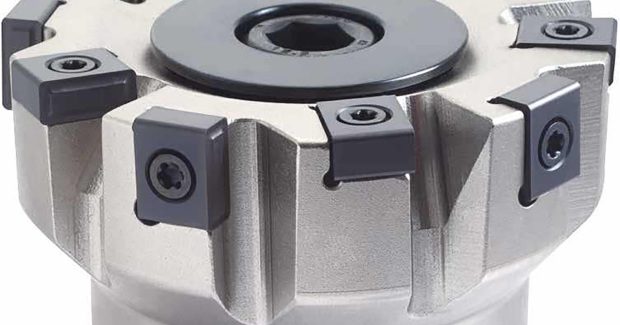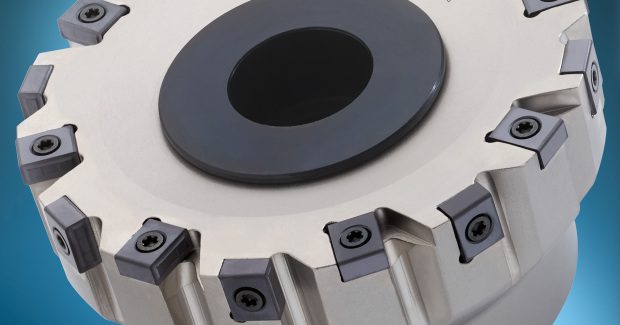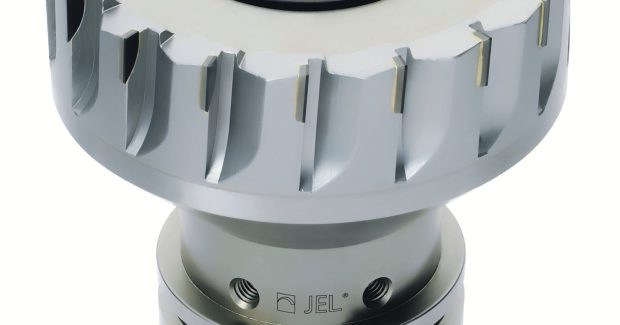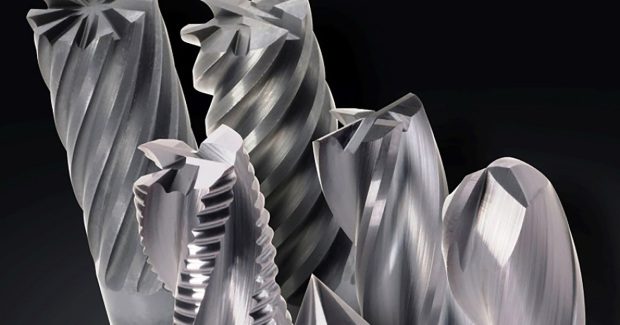A Renewed Focus on Milling
These advanced cutting tools bring new attention to boring, reaming, threading and milling different materials that range from 4140 steel to grey cast iron to aluminum 7075.
Posted: December 4, 2014
Boring, reaming, threading and milling are the core applications of a line of tools from KOMET of America (Schaumburg, IL) that renew the focus on milling in a wide range of materials, from 4140 steel to grey cast iron to aluminum 7075.
QUATRON HI.FEED MILLING CUTTER
The Quatron hi.feed milling cutter, inspired in part by the successful line of KUB Quatron® drills and using the same inserts, is designed for a wide array of milling operations, including plunge milling, a demanding process that requires a high performance roughing tool that can quickly remove large quantities of material. The Quatron hi.feed is ideal for plunging needs when cutting deep grooves, large cavities and large projection lengths in unstable conditions.
Cost-effectiveness is central to the design, which features indexable inserts with four cutting edges each to achieve a high volume of chip removal and increased productivity. Expanding on the success of the tried and tested KUB Quatron® solid drill range, this unique cutter technology now extends to a range of milling cutters and roughing tools intended for the fast removal of large volumes of material. Features include:
- The mill cutting of bores with just one tool rather than enlarging them with several drilling tools.
- Four cutting edges per insert, which lowers the production cost per cutter.
- Increased productivity thanks to high-volume chip removal.
- Deflection of passive forces in an axial direction. Plunge milling puts less stress on the spindle thanks to the lower loading.
- Variable manufacturing of different diameters.
- Low cutting pressure.
- A tough substrate that allows universal use for steel, cast iron and stainless materials.
- High feed rates up to 2 mm per cutting edge.
HI.AEQ FACE MILLING CUTTER
The hi.aeQ is a noteworthy and innovative tool that is ideal for counter-boring and milling operations, as well as the shoulder and face milling of cast iron. The hi.aeQ features a nickel-plated body and tangentially positioned Q80 indexable inserts, which are fitted in an alternately standing/laying arrangement that provides a high number of cutting edges as well as high stability and low vibration. Shops will find that this results in higher cutting efficiency and lower power consumption, alongside reduced spindle loads and quieter operation.
In the standing-lying arrangement, each indexable insert yields eight usable cutting edges, making the tool especially cost-effective. These extremely stable tangential indexable inserts, when combined with selected cutting tool materials and coatings, provide a great economic advantage when machining cast iron materials. For example, the innovative hi.aeQ arbor face milling cutter is ideal for reliable step and face milling of cast iron materials. It features a high number of teeth and low cutting forces. Another example are the Q80 tangential indexable inserts, which are designed for counterboring and milling operations.
The standing-lying arrangement also offers:
- High stability for high cutting efficiency thanks to the use of tangential screw-fit Q80 indexable inserts.
- Eight usable cutting edges thanks to indexable inserts which are fitted in an alternately standing and lying arrangement.
- Low power consumption thanks to low cutting forces and a low-vibration, quiet milling characteristic reduces the spindle loads.
- This concept guarantees extremely high process reliability when combined with modern, matched substrates and coatings.
- Both PVD and CVD-coated indexable inserts are available.
- If internal coolant supply is used, optimum cooling of every cutting edge is achieved by using the coolant sleeve.
JEL® SOLID CARBIDE MILLING CUTTERS
The full range of JEL® standard solid carbide milling cutters can mill a range of 3.0 mm to 25.0 mm diameters in cast iron, steel, aluminum, and non-ferrous metals used for soft and hard machining (up to 65 HRC) and in mold and die making. Tools for aluminum and non-ferrous metal working include these versions:
- End milling cutter
- Roughing end mill
- HPC milling cutter
- Spherical cutter
- Torus milling cutter
- Chamfer milling cutter
- Radius milling cutter
Application benefits include comprehensive standard range from stock, high productivity due to the perfectly tuned grade profile and coating for all of the workpiece materials, and original regrinding service and recoating service that is guaranteed by a comprehensive network of professional KOMET SERVICE™ partners.
JEL® PCD MILLING TOOLS
Machining aluminum can be tough, but JEL® PCD milling tools are tougher, such as the new JEL PCD face milling cutter that boasts a high number of cutting edges for high feeds, a long cutting depth and a long tool life. These PCD milling cutters are flexible and easy to handle, and they can be used in a range of operations. This face milling cutter is reliable, requiring no adjustment thanks to its monoblock design. It features an internal cooling supply that flows to the cutting edge via a coolant screw.
This face milling cutter provides outstanding cost efficiency and is available in Type 140 for Rz greater than 10 µm and Type 150 for Rz less than 10 µm. Both variations are available from stock in diameters from 40 mm to 160 mm. The JEL PCD face milling cutter is ideal for roughing and finishing cast or solid aluminum for automotive, aerospace, aluminum foundries, and pneumatics and hydraulics.
Take a look at this machining application example of the JEL PCD face milling cutter:
- Part: housing
- Machine tool: Chiron Mill 2000
- Machining application: Face milling of the sealing surface and mounting domes, upper side and underside
- Material: GAlSi9
- Cutting depth: 4 mm
- Tool: 37150026004000 PCD face miller x40, NZ10 HSK-A63
- Cutting data: vc =1,507 m/min = 12,000 rpm (Smax.) | fz = 0.05 mm/tooth = 6,000 mm/min
- Surface finish: Rz 1.51-2.50
The application benefits from this machining example include:
- Cutting depths of up to 8 mm using firmly soldered cutting edges in a solid basic body.
- Short cycle times through use of maximum number of cutting edges and highest cutting speeds.
- No adjustment necessary due to Monoblock design.
- Attainable surface quality: Rz less than 10 µm (type 150) due to fine balancing and extremely tight manufacturing tolerances.
- Type 140 variation achieves Rz greater than 10 µm with eroded cutting edge design, or Type 150 achieves Rz less than 10 µm with special cutting edge design.
- The central internal cooling supply is fed to the cutting edge via a coolant screw.
KOMET of America, Inc., 2050 Mitchell Blvd., Schaumburg, IL 60193, 847-923-8400, Fax: 800-865-6638, customerservice.us@kometgroup.com, www.komet.com.








